
back to Elongated Skulls from Ancient Races on Earth

Contents of this page:
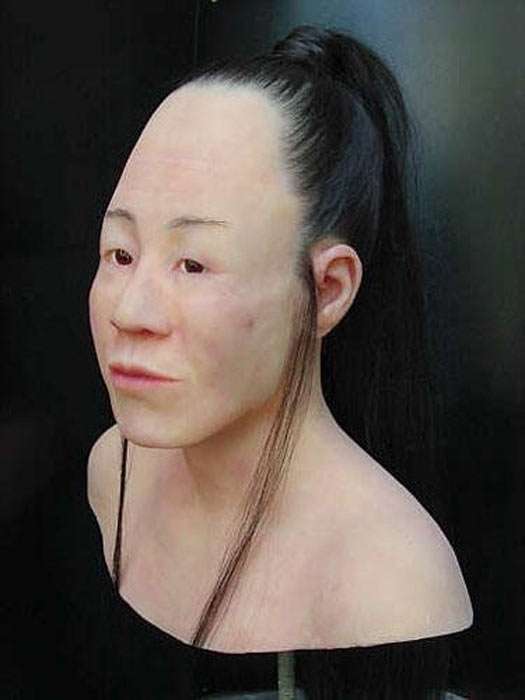
What a Hun woman looked like. Image by
Marcel Nyffenegger.
|
There was a time when human species with elongated heads, of various types and races, lived all over the planet. They were matriarchal, peaceful, and had great knowledge and skills, especially in working with stone. In some places they were the rulers, while in other places they were living in small communities. All that changed when humans with round skulls multiplied and spread all over the globe, taking over the territory of the long head people. The long head people were very intuitive and energy sensitive, and were the builders of the numerous earth works and stone megaliths. They worked with the energy lines and spots of the Earth. It seems that the round head people were the first to work metal, and as a consequence fabricated metal weapons, which they used to subjugate or wipe out the long head people. The round head people were very war like, patriarchal and thrived on conquest. Modern day humans are the descendants of these round headed people, and maybe that is the reason why our leaders decided to let the physical evidence of the long head people disappear into the basements of museums, and to 'forget' what archaeologist had found during the 1800's and early 1900's in their excavations. Bear in mind that there is a lot of variance in the opinions of archaeologists in regard to the different human and hominid races, their origins, and their migrations. New DNA analysis of the bones and skulls have yielded new insights in the history of all those races, and changed a lot of theories. This chapter shows that long head humans were once prevalent in Europe. |
|
The Old Archaeological Records There are not that many pictures of elongated skulls in Europe, that is, those that are displayed in museums. It seems that archaeologists are uncomfortable with these finds. It is becoming more and more clear that these people with elongated heads were a separate human race. Their long heads were not the result of cradle-boarding or head binding; they were born with it. It was a genetic feature. The interest in the elongated skull people has risen tremendously. The primary focus is on Middle and South America where most of these elongated skulls have been found and are displayed in museums. However these races of beings were once present all over the world. In contrast to South-America where a multitude of extreme long skulls can be found in museums, in Europe elongated skulls are just not talked about. We now know that many elongated skulls have been found on Malta, but the skulls have disappeared into the basement of it museum. The long headed people of Europe lived in the Stone age period of roughly 4000 to 3000 B.C. This was well known to the archaeologists of the 19th century, who dug up all these skeletons. The elongated skulls were sent to different museums, and... disappeared into their basements. I have looked into the old archaeological publications, which are available online. I will give direct quotations, with a link to the original documents. These archaeologists were well convinced that at one time the whole of Europe was populated by a different human race with elongated heads. Text between square brackets [] and bold emphasis are mine. |
|
The Difference Between Elongated and Round Skulls We saw this in the chapter of Elongated Skulls: Physical Features but it important to go over this in order to understand the archaeological records that have been quoted on this page. Archaeologists of the 19th and early 20th century based themselves on the cephalic index to measure skulls. The cephalic index, or cranial index, is the ratio of the maximum width of the head multiplied by 100 divided by its maximum length, in the horizontal plane, or front to back. It is important to memorize these terms, as they are often used in the archaeological records. |
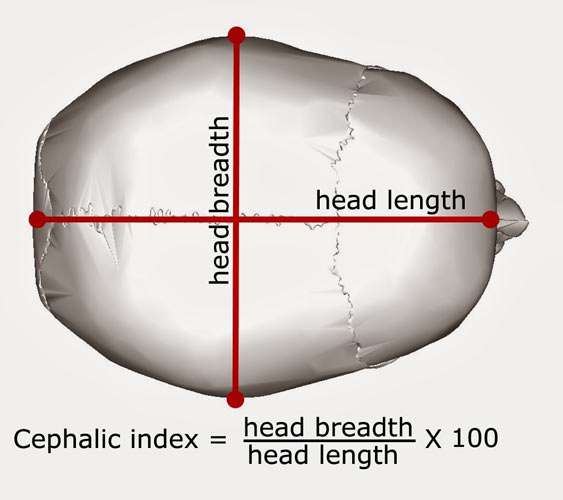
|
Round skulls, or brachycephalic skulls, are typical for what we know as present day humans, or Homo Sapiens. Their cephalic index is larger than 81-83, what means that the width of the face is slightly smaller than the length of the skull. In other words, they have a very round skull. When a skull has a cephalic index smaller than 71-73, its length, front to back, is a lot larger than with the round skulls. These skulls are called dolichocephalic skulls, or long head skulls, or elongated skulls. These skulls can quite different can can be considered to belong to another human race. Mesocephalic skulls are those that are in between the round and long skulls, often ovoid in shape. The are the result of interbreeding of round skull and long skull people. When reading the following text, keep in mind these terms. I will also use the term 'round skull people' when referring to Homo Sapiens, or what we now call modern man. |
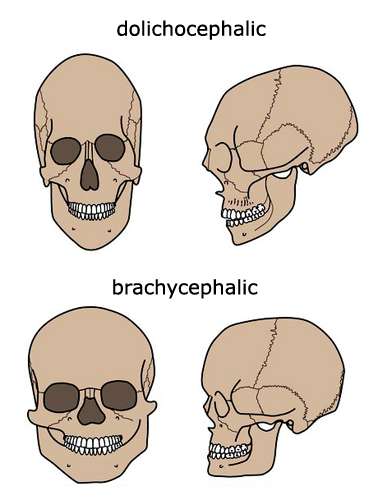
|
The Difference with South-American Elongated Skulls The head length of the dolichocephalic skulls, or long head skulls, in Europe is significantly more extended than round skull people to qualify as belonging to a separate human race. In South-America the elongation of the skulls is quite long and often upwards or slanted. However we also find examples of elongation in the horizontal direction, that is, the top of the skull is often flat and the elongation extends backwards. This type of skull is predominant in Stone Age Europe. Below are examples of the South-America elongated skulls of different varieties. As you can see, the forehead often continues upwards. |
|
|
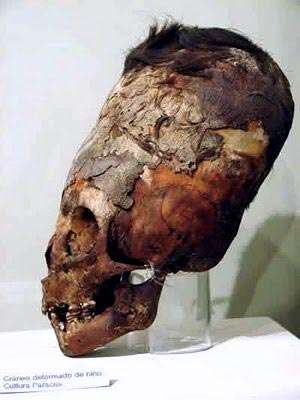 |
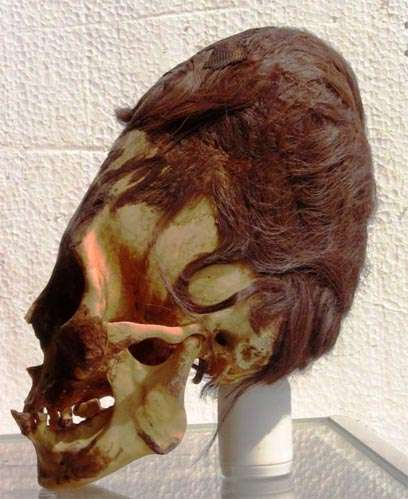 |
|---|
|
There are also skulls of which the forehead is slanted backwards, at an angle, or it goes immediately backwards like the one on the right (below). |
|
|
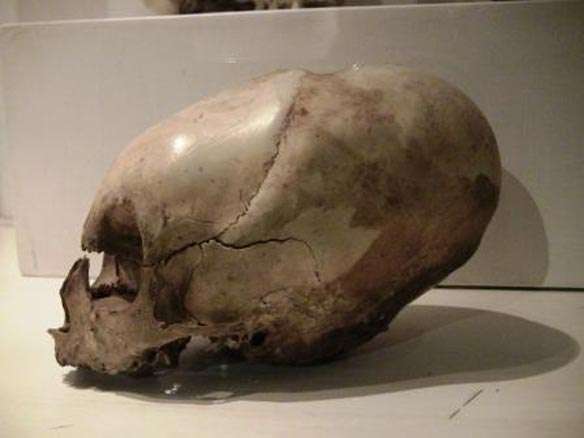 |
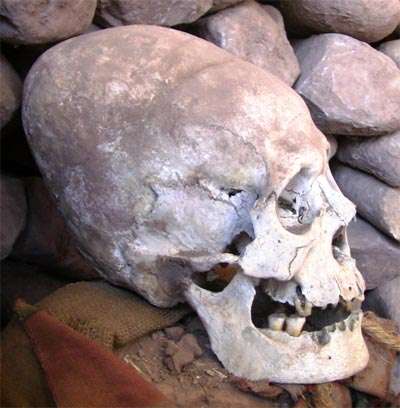 |
|
You can see that all the South-American skulls are quite elongated, except for the last one. In Egypt, we find a 'horizontal' elongation that is still quite extensive. The Akhenaton family: |
|
Nefertiti |
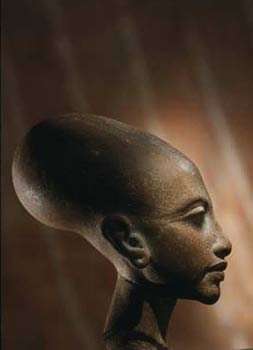 daughter of Akhenaten and Nefertiti |
|
In Europe the elongated skulls, at least what is publically known (who knows what is in the basement of the museums) are shorter. There are some of which the forehead is slanted upwards, but most seem to be elongated in the horizontal plane. |
|
Germany, a rather large elongation |
 Germany, forehead slanted upwards |
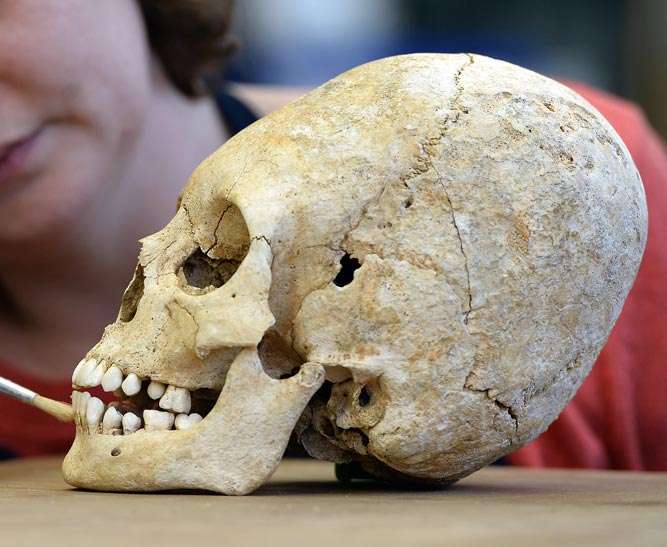 France, forehead slanted upwards |
|
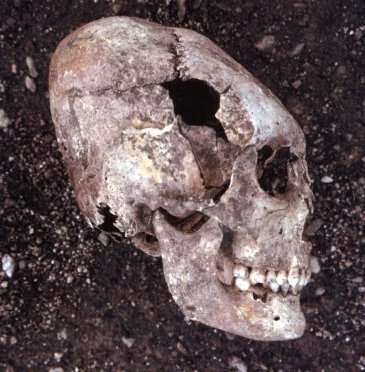 Austria. horizontal elongation |
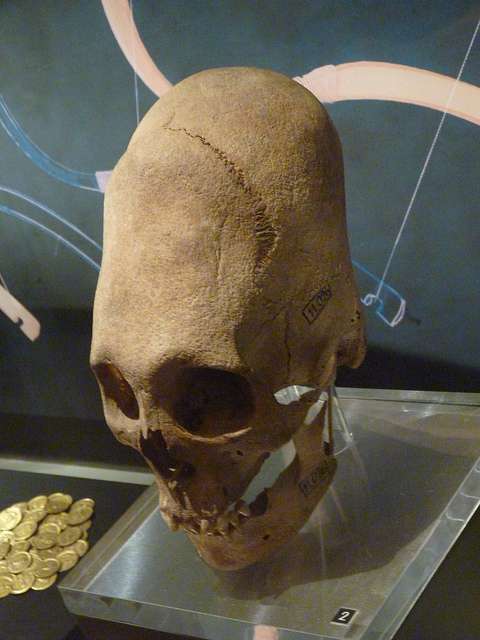 Hungary. horizontal elongation |
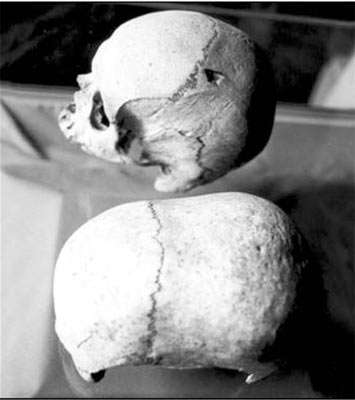 Malta, horizontal elongation |
|
Below we will explore the old archaeological records, and some drawings that were made at that time, that will show that the long head people in Europe seem to be of a very different group than those in South-America. In Europe the long head people were rather small in stature: about 5 feet 5 inches (John Thurnam in On the two principal forms of Ancient British and Gaulish Skulls (1865), page 40-41). It is without question that Europe was once populated by both round skull and long skull people, as evidenced by the archaeological finds: "Several hundred skulls, found in Neolithic burial-places in France, Switzerland, Austria, and Germany, exhibit an intermixture of brachycephals [round skulls] and dolichocephals [long skulls]. According to the more or less frequent occurrence of the former in relation to the latter in each burial, we may, with Hervé, trace the route followed by these brachycephals of Central Europe, from the plains of Hungary, by the valley of the Danube, into Belgium and Switzerland; from these last-named countries they flung themselves on the dolichocephalic populations of France and modified the primitive type, especially in the plains of the north-east and in the Alpine region. "But if the “neolithic” people of France and Central Europe belonged to at least two distinct races, the same has not been the case with the other countries of our continent. In the British Isles we find ourselves, on the contrary, as regards this period, in presence of a remarkable homogeneity of type; it is without exception dolichocephalic, with elongated faces, such as are found in the long-barrows." Source: The Races of Man, by J. Deniker, 1900, page 313. Although some of the long head people were murdered and wiped out, as was the case in England, in the European continent, there was plenty of evidence that both races lived side by side, and there probably was interbreeding, causing the the gradual disappearance of elongated heads. |
|
England: Genocide of the Long Heads 1. Long barrows, long skulls; round barrows, round or short skulls John Thurnam, a prominent English archaeologist of the 19th century (1810-1973), excavated and examined the barrows in the Salisbury plain and came to the conclusion that the long head people were the oldest race in England, and were replaced by an invading force of round skull people. The long skull people lived around 4000 to 3000 BC, which is considered the (end of the) Stone Age. They were usually called the Ancient British People. Their skeletons were void of metal ornaments or weapons, so it was thought that they only had stone implements. “In addition to the brachycephalous skulls [round skulls], of which so many examples are described in the Crania Britannica, a less number of decidedly dolichocephalic crania [elongated skulls] have also been depicted. These are principally derived from the chambered long-barrows of North Wilts and Gloucestershire, being the district of the British Dobuni, the same tribe which, at the time of the conquest under Claudius, was subject to the great neighbouring tribe of the Catuellani. There is no well-authenticated proof that metallic objects, whether of bronze or iron, have in any case been found in the undisturbed chambers of these tombs, which, however, yield well-chipped flakes and arrowheads, and also axes of flint. “ On the two principal forms of Ancient British and Gaulish Skulls (1865), by John Thurnam. Around 3000 BC, tribes of round skull people came around and murdered the long head people. They buried them in their long barrows, and closed off the entrances. The round skull people were called the Gaulish tribes, who took over the territory, and then constructed their own barrows, but of a round shape. This period is called the Bronze Age. The Bronze Age round barrows, built by the round skull humans, is from 2200 to1800 BC. The fact that long head skulls were primarily found in long barrows and round head skulls in round barrows lead to the axiom "Long barrows, long skulls; round barrows, round or short skulls." Source: Part IV, Chapter XVII. The Archaic Character of the Contemporaneous Relics found in Combination with them. This chapter appeared in Proceedings of the Society of Antiquaries of Scotland Volume 6 (1864-5); also From the Memoirs of the Anthropological Society of London, Vol. III', The Royal College of Surgeons of England, page 124-126 Both the long and round barrows were used for initiatory, astrological and energetic purposes, and were not intended as graves. When the archaeologists excavated both types of barrows, there was a clear difference between the two. The long barrows contained the remains of the long skull people. The archaeologists were really surprised that the burials of long head people in the long barrows did not have the signs of respectful burials. These burials were disorderly, the bodies often covered with dirt and rocks, and many showed clear signs of violent deaths, usual by severe damage to their skulls. In many cases the victims skull was cleft in two by a sword, with great force. The archaeologists came to the conclusion that an invasive force of round skull people had wiped out the long head people, and basically took over their territory. The round barrows, constructed by the round skull people, eventually also functioned as resting places for their dignitaries. These contained respectful burials, and the remains still had their metal ornaments and weapons, as tokens of respect. Not all long head skulls showed signs of a violent death, but fractured skulls were a constant recurrence in the excavations of the long barrows. Here are some examples of what the archaeologists found. “In the south-east angle of the chamber, to the left of the entrance, was the skeleton of a youth of about seventeen years of age, apparently in a sitting posture. The skull was extensively fractured at the summit by what appeared to have been the death-blow.” ... Almost in the centre of the floor was the skeleton of a man of about fifty years of age, of large and powerful frame, the humerus thirteen inches and the thigh-bone twenty inches in length. The teeth were very much eroded, the bones thick and heavy. A fracture, probably the death-wound, extended from one temple to the other, through the forehead into the right cheek, entirely severing the malar bone, which had fallen off below the skull, and was preserved by the clay in which it was embedded, of an ivory-like hardness, contrasting strongly with the light friable character of the bones from which it had been separated. The skull, somewhat large and flat, was of an elongated oval form.” In 1801 Mr. Cunnington opened the long barrow near Heytesbury, called "Bowls' Barrow," in which he found several skeletons crowded together at the east end, the skull of one of which "appeared to have been cut in two by a sword." Source: Examination of a chambered long barrow at West Kennet, Wiltshire, by John Thurnam (this article was published in Archaeologia Or Miscellaneous Tracts Relating to Antiquity, Volume 38, in 1860, page 405. |
|
3. The Tilshead Long Barrow: a very Elongated Skull Tilshead is a small village in the county of Wiltshire in the Salisbury Plain, England. The Tilshead Long Barrow is a very large and massive barrow. John Thurnam, who excavated the site in the 19th century, found the remains of one woman at the center of the barrow, and eight skeletons at one end of the barrow. The woman in the center might have been an important matriarchal leader of a tribe. This 'burial' is interesting because the remains of the group of people were those of 3 men, 3 women and 2 children of only 1 to 2 years old. All of them were brutally murdered including the two children. Clearly, the round head people took no mercy on children either. If the woman at the center was a matriarchal leader, it is likely that the eight other people were her family. John Thurnam describes his excavation of the Tilshead long barrow as follows (Further Researches and Observations on the Two Principal Forms of Ancient British Skulls, page 27-39): "Later in the year 1863, I successfully explored another of the long earthen barrows of South Wilts. This was in the parish of Tilshead, about seven miles north of that last described, and not far from the eastern extremity of the ancient vallum called Old Ditch. It is now covered with trees of about twenty years growth, and is of smaller size than that of Winterbourn-Stoke; being about 210 feet in length, 50 in breadth, and six or seven in height. There is the usual ditch on its north and south sides. Excavating near the east end, a stratum of black earth was found at the depth of about five feet; and in and below this, a pile of human bones, closely packed, within a space of less than four feet in diameter and about a foot and a half in depth. They proved to be the remains of eight skeletons, strangely cemented together; so closely as to show, that if not interred after the decay or removal of the flesh, the bodies must have been packed together as closely as possible in the sitting or crouching posture. The lowest skeleton, covered by the others, and most centrally placed, was that of a woman; whose skull, the best preserved of the whole, is described further on. There were no relics whatever with the skeletons; nor were any cavities scooped out in the chalk at the base of the barrow disclosed; though there can be little doubt such "cists" would have been found if the excavations had been sufficiently extended. "The skeletons were those of three men, three women, and two infants, from one to two years of age. The length of the bones of the limbs was not above the medium, and implies a stature of from 5 feet 5 inches to 5 feet 8 inches, for the men and 4 feet 9 inches to 5 feet 3 inches, for the women. The restoration of the skulls from the many fragments in which they were recovered, was a work of great labour. The first thing observed was that nearly all had been most extensively cleft, apparently during life ; the gashes in two of the male skulls (Nos. 2, 3) being of remarkable length and width ; in the one extending from the forehead to the vertex, and in the other traversing the skull in all directions. In a female calvarium (No. 6) the clefts are nearly as extensive. In the other male skull (No. 1) the largest of the series, the clefts are confined to the two temporal regions, and are somewhat more ambiguous in their character. A similar doubt may apply to a second female skull (No. 5);..." John Thurnam thought they were the victims of funeral sacrifices. However it looks more like plain murder by the round heads. After all the 'burials' were done in a very disrespectful manner, and here at Tilshead, the victims' death was excessively brutal, with exception of the sole remains of a woman in the center of the barrow: "The only skull without greater or less trace of violence (No. 4), is that referred to as the deepest and most centrally placed; and I am inclined to conjecture that this sepulchral mound was raised in honour of some woman of rank or female chief; the examples of Boadicea and Cartismandua showing that in Britain, supreme power was at times exercised by women. All the skulls are of the elongate form, with the occiput full and prominent; the mean breadth being about as 71 to the length taken as 100; the largest male skull has a breadth of 68. There is postcoronal depression in most, and to a marked extent in one of the female skulls (No. 6). Very decided traces of it are observed in the centrally-situated female skull. This cranium, the only one with the facial bones and lower jaw, is a remarkable specimen, being not only very elongate, but having an extremely depressed and flattened vertex; the greatest height being only as .65 to the length, (Plate III.) " Underneath is Plate III showing his drawing of the woman's skull. Click on the image to see a larger version. |
|
Maria Wheatley, a present-day dowser, managed to track down the woman's skull to Cambridge University, and asked to see the skull, and take pictures. So finally we got a picture of an elongated skull in England! The following is the only picture Wheatley showed at a presentation in the 3rd international conference from the Bases project of Miles Johnston. You can watch it at YouTube. She starts talking about the skull at about 11 minutes into the video. This is her picture of the woman's skull: |
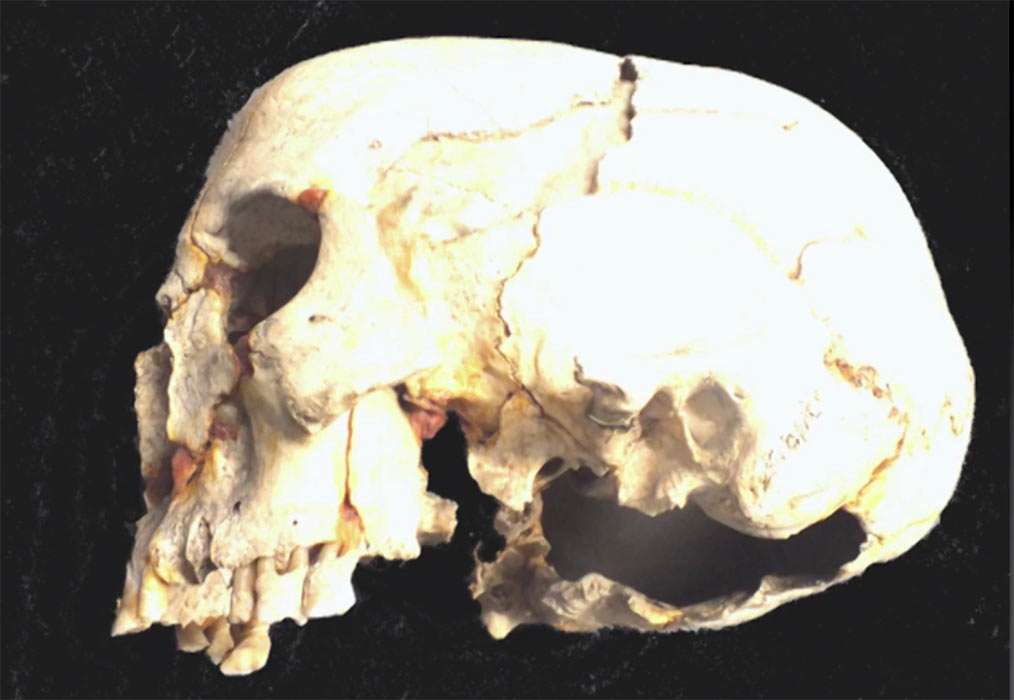
|
4. The Effacement of the Sagittal Suture of Elongated Skulls Some people have stated that some of the elongated skulls did not a sagittal suture because the excavated skulls did not show one. This would imply that they were born with two instead of three skull plates. However there is an underlying process that should be taken into account.
John Thurnam, who was also a craniologist, never mentioned a complete absence of the sagittal suture in any of the excavated skulls. A missing sagittal suture would have been a major find. In the Thurnam's drawings of the elongated skulls, a sagittal suture is always present. In Further Researches and Observations on the Two Principal Forms of Ancient British Skulls, page31-35, Thurnam describes the various anatomical differences between the long skulls of the Ancient British people and the round skulls of the Gaulish people. The long head skulls has various characteristics that makes them a very different race from the round skull people. They facially looked different. In regard to the sagittal suture, on page 35, he says: "The dolichocephalous skulls [long skulls] from the long barrows differ, likewise, in a very curious respect, from those of the brachycephalous [round skulls] series; viz., in their greater liability to premature obliteration of the sutures. This can hardly be regarded as other than a race-character, which these skulls exhibit in common with those of other dolichocephalous peoples..." So, it is not that the long heads were missing the sagittal suture. The long head race had a tendency to fuse together the cranial plates at a much faster rate than was and is the case with the round heads. Sometimes it already happened when the long head person was in its infancy. "In the same class of skulls, the sagittal suture has, in several instances, been found more or less effaced,..." Thurnam surmises that the reason for early obliteration of the sagittal suture is an exuberant ossification [bone formation] produced by a diet high in meat, and also because the closer contact of the skull plates at the sagittal suture [with long skulls] by which ossification happens much earlier in life. So, the long heads are not missing the sagittal suture. It ossified very early in life, so it became hardly perceptible later on in life. It is definitely a very defining characteristic of the long heads, as we do not see this happen with round skulls. "No such effacement has been observed in the brachycephalous [round] skulls from the round barrows." I also found a curious reference to another feature of the sagittal suture associated with a long skull. On page 6 of On the two principal forms of Ancient British and Gaulish Skulls (1865), John Thurnam talks about the findings of another archaeologist, Mr. Bateman, who says about the elongated skulls found in the long barrows of the Dobunian district: "The interments within the chambers have been many, and apparently continued over some length of time. They are marked by a strongly-defined type of skull, the more obvious feature being excessive elongation and a laterally compressed appearance, enhanced sometimes by the sagittal suture being elevated into a ridge." The ridge feature was also found in a dolichocephalic skull in Scotland: "In the norma verticalis each skull had an elongated ovoid outline, though one was proportionately wider than the other, and the cephalic indices were respectively 75 and 72 '8, dolichocephalic; the sagittal line was ridged, and the side walls were bulging,..." (Source: A contribution to the craniology of the people of Scotland. Pt. I. Anatomical. by Turner, Wm. (William), Sir, 1832-1916; Royal College of Surgeons of England, page 587) This source cites several dolichocephalic and hyperdolichocephalic skulls in Scotland. |
|
5. The Galley Hill Skull: an Extreme Elongated Skull I am mentioning this skull because of it extreme elongation, and it antiquity. This skeleton was found in 1888 in Galley Hill, in Kent, England, but left in place. It was studied by a couple of archaeologists over a period of many years, and was the debate of controversial theories, because it was present in a layer of soil that would date it to a period much older than the theories at that time would allow. In 1894 E. T. Newton carefully excavated it. Arthur Keith came to the conclusion that this skeleton was as old as the layer of soil it was found in, that is, about 250,000 years ago. It was thought that at that time, only a very primitive man existed, but the skeleton and skull showed that "Certain it is that the remains found at Galley Hill are not those of a low type of man. In size, and in the richness of its convolutions, the brain of Galley Hill man does not fall short of the average man of to-day." (The Antiquity of Man by Arthur Keith, 1915, page 185) "The skeleton does not show a single feature which can be called Neanderthaloid, nor any simian feature which is not also to be seen in the skeletons of men of the modern type. The Galley Hill man represents no strange species of mankind; he belongs to the same type as modern man." (page 186-187) "The man was pronouncedly long-headed, the width being approximately 69 per cent, of the length. We have already seen that most of the Palaeolithic Europeans, especially of the Aurignacian period, had exceptionally long heads." (page 187) That is a cephalic index of 69, what is classified as hyperdolichocephalous, or an extreme elongation. Interestingly, in that last quote, he mentioned that most Europeans in the Stone Age (2.6 millions years ago to 10,000years ago) were long heads! The Aurignacian period is from 43,000 years ago to 28,000 years agp. You can find a detail description of this skull in The Antiquity of Man by Arthur Keith, 1915 from page 179 to 193. |

The Galley Hill skull
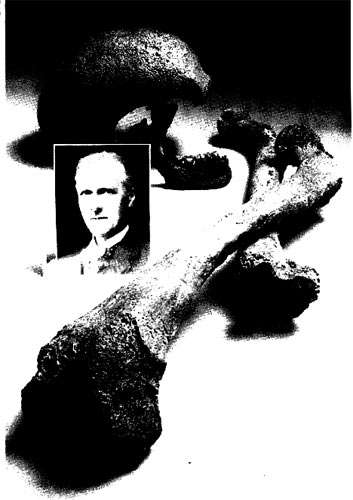
Arthur Keith and the Galley Hill specimen
|
I should also mention here that dolichocephalic skulls have also been found in Scotland. An example is the archaeological record of skulls found on the island of Orkney: On the osteology of the ancient inhabitants of the Orkney islands by Garson, J. G. (John George); Royal College of Surgeons of England, 1883. |
|
In the European continent the situation was different. Both long and round headed races were living amongst each other, and it was difficult to figure out the identity of these tribes, and how they moved around on the continent. In some burial sites both skull types were found together, what shows that at some places they were living together, and most likely cross-bred. There were different theories and names of tribes assigned these prehistoric people, as not all archaeologists agreed about the origins of these people. John Thurnam, the English archaeologist, also studied the findings of the French archaeologists, and he came to the conclusion that the long head people in England were Teutonic in origin, which roots in Anglo-Saxon and Scandinavian sources; and in France there were equally Teutonic with roots in Gothic, Burgundian, Frankish, or Scandinavian sources. More details at Further Researches and Observations on the Two Principal Forms of Ancient British Skulls,(1965), page 8.65), page 8. The following shows a couple of examples of long head people in European countries. |
|
It appears that some of the dolichocephalic tribes were still present in more recent times. In a dispute about the origins of the Basques (in Spain), the archaeologist Broca, in 1862, 'procured' 60 Basque skulls from an old, unnamed cemetery in the province of Guipuzcoa, and the large majority were dolichocephalic. However over time, the dolichocephalic type of skulls disappeared, probably by cross breeding with the round skull population. (Source: Paul Broca, by Francis Schiller, 1979, page 150) Picture of one of the Basque skulls ( from Further Researches and Observations on the Two Principal Forms of Ancient British Skulls, page 43): |
|
I remember that in the Museum Ten Duinen, in Koksijde, Belgium, they had trepanned skulls and one elongated skull on display in the 1980's. These were found during an archeological dig inside a medieval monastery! In 1886, in the village of Spy, in the province of Namur, two skeletons, of a man and a woman, were found in front of a cave, of which the skulls were dolichocephalic. They were dated at 3600 years ago. Their skull characteristics were very different than those of humans (Homo Sapiens) because they were very simian (ape-like). The shape of the crania found at Spy had a long, narrow, low skull with very retreating forehead, enormous brow ridges, powerful masticating apparatus, heavy under jaw with broad ascending branch, no chin. They were classified as Neanderthals. There is a very detailed description of the skulls in "The Genealogy of Man" is an article from The American Naturalist, Volume 27, 1893, page 327 to 334. |
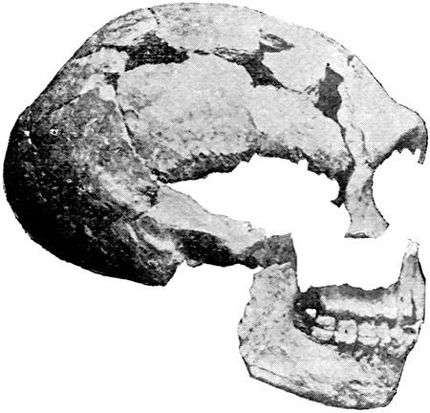
One of the Spy skulls from The Races of Man, by J. Deniker, 1900, fig. 86The Races of Man, by J. Deniker, 1900, fig. 86
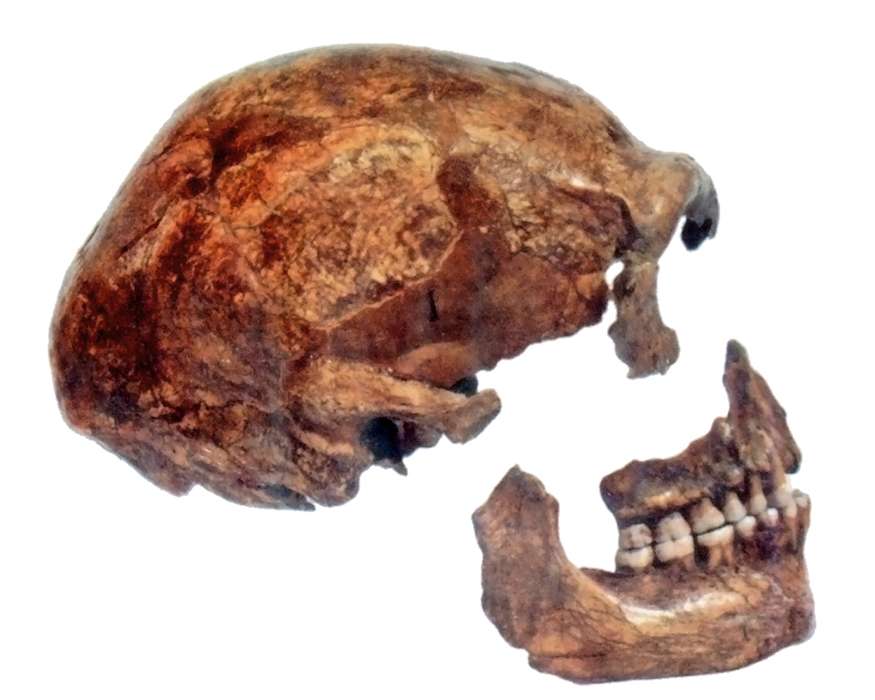
from Wikipedia
|
In some burial sites both round and elongated skulls were found together, what shows that at some places they were living together, and probably cross-bred. An example of this was found in 1908, in the Ofnet cave which are explained in detail in Men of the old stone age, their environment, life and art, by Osborn, Henry Fairfield, 1918, Page 479 – 481). |
|
This is an elongated skull at the Dossenheim Museum in Germany: "elongated skull and grave artifacts of 6th century Frankish woman". It was excavated in 1955, in Dossenheim near Heidelberg in a women's grave, which was clearly outside the local cemetery. The skull had only three teeth, so she must have been very old.
|
|
This skull is in a museum display in Tuchersfeld, Germany. The inscription with the skull states that about 20 of these male and female skulls were found in the Franconia-Suisse area of Bavaria, Germany. A very elongated skull! |
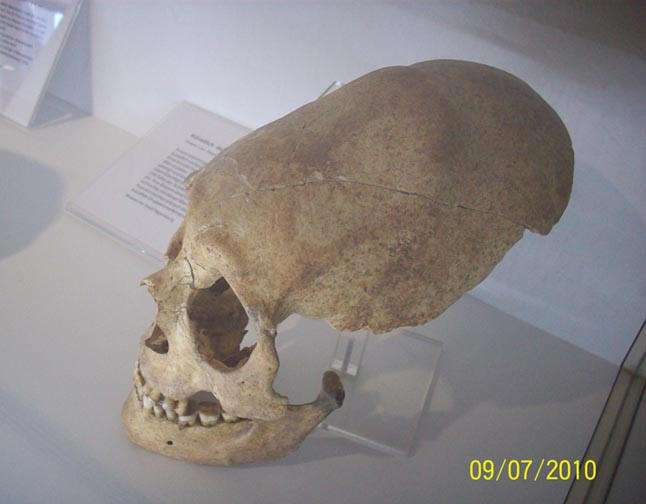
|
Skulls in the State Collection for Anthropology and Palaeoanatomy Munich: (The original scientific publication: Population genomic analysis of elongated skulls reveals extensive female-biased immigration in Early Medieval Bavaria) DNA from 40 individuals, buried in Early Medieval (5th and 6th century) sites Altenerding and Straubing in Bavaria, was analyzed. Those who had normal skulls were from Barbarian tribes in Western and Central Europe. Nine were women with elongated skulls who actually came from southeastern Europe, specifically Bulgaria and Romania – meaning these women would have likely had darker hair and darker eyes than their Bavarian associates, not to mention their expansive, receding foreheads. It is not clear why these women would have travelled that far to marry within these tribes. |
|
The middle and right skull are from the local Barbarian tribes. The one on the left is a female elongated skull from Southeastern Europe. Notice that this skull is of the 'tower' variety, going straight up. |
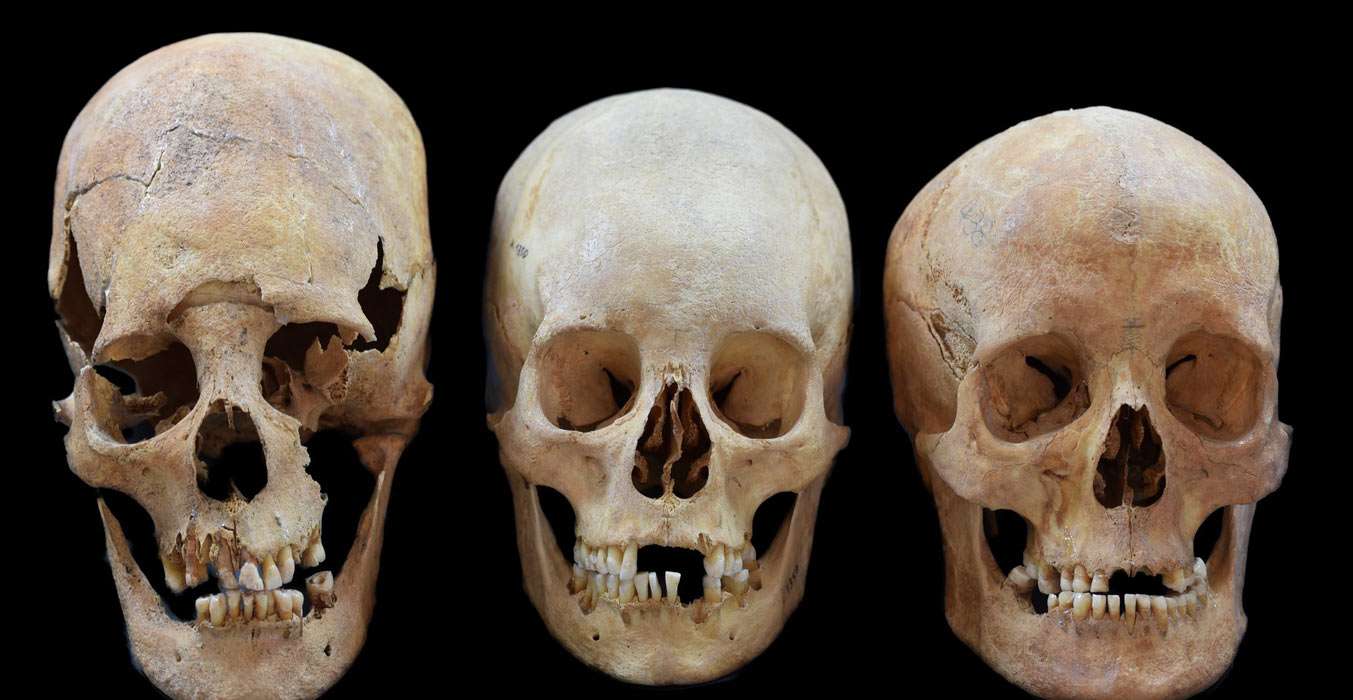 front view |
|
Side view of the female skull in the above pictures. |
Another elongated skull. This one is slanted backwards. |
|
Conical head of a 30 to 40 year old Alemannic woman of the early 6th century; shown at the Württembergisches Landesmuseum, Stuttgart, Germany. |
|
Skulls found in the cemetery of Altenerding, dating from the 5th to the 6th century. |
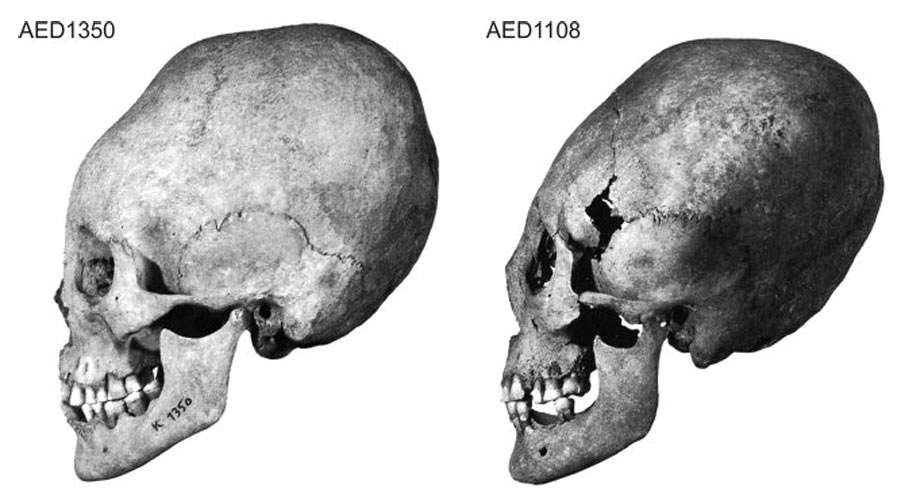 |
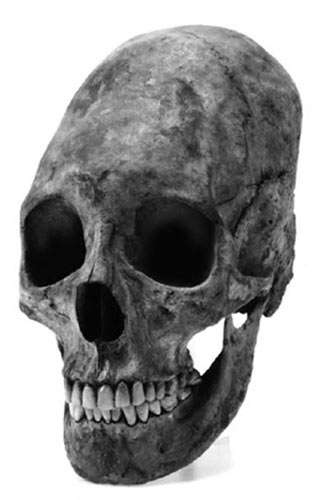 |
|
The skull is of a Merovingian (5th-8th century A.D.) skull of a woman. This elongated skull was found during excavations in an industrial park in Pays de Sainte Odile (Obernai, in the northeastern French province of Alsace) France. In 2013, Inrap ("Institut national de recherches archéologiques préventives") completed a major search of over 7.5 acres, which has resulted in the discovery of a succession of Neolithic, Gallic, Gallo-Roman and Merovingian societies. They found several tombs, jewelry items, ceramics, amphorae, coins and other items. When they found the elongated skull, the archeologists brought up their favorite explanation of deformation of the cranial plates. Original article is at INRAP. |
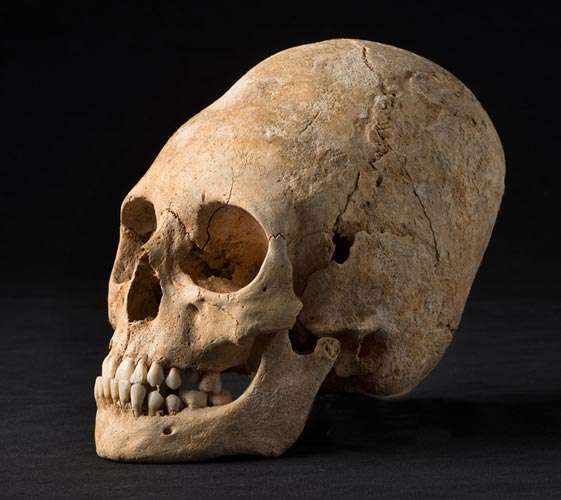 |
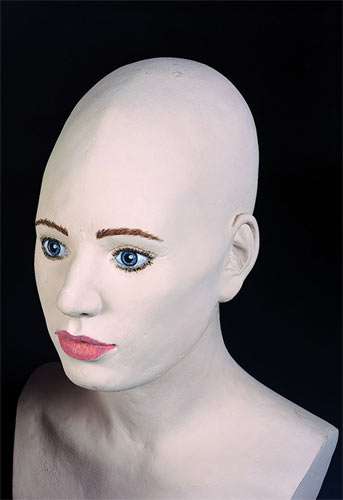 reconstruction of the skull |
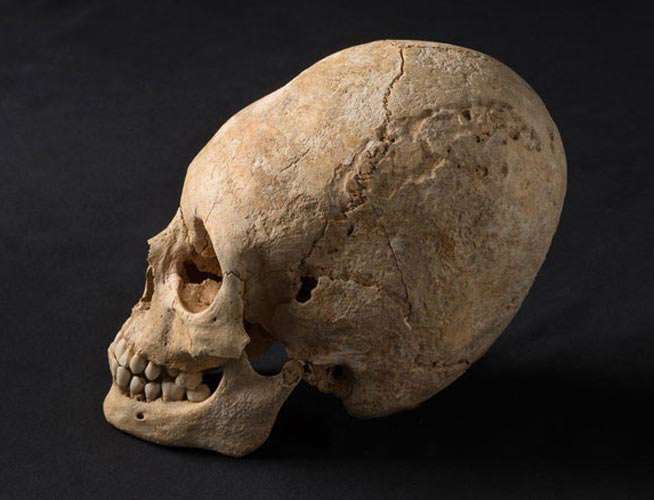 |
 |
|
This skull is from The History of the Burgundians with accompanying text: "Archeologists have identified the first Burgundian (Burgundia was a historical region in east-central France) cemeteries owing to the presence of individuals with cranial deformations. The majority of these remains were discovered on the banks of the river Leman, notably at Geneva, Nyon, Genolfier, St-Prex, Lausanne and La Tour-de-Peilz."
|
|
A Sarmatic-Alanian woman’s skull from Pontoise, and from the Merovingian Dynasty (5th to 8th century). Pontoise is a commune in the northwestern suburbs of Paris. |
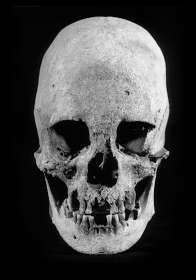

|
Skull in Kunsthistorisches Museum, Vienna. |
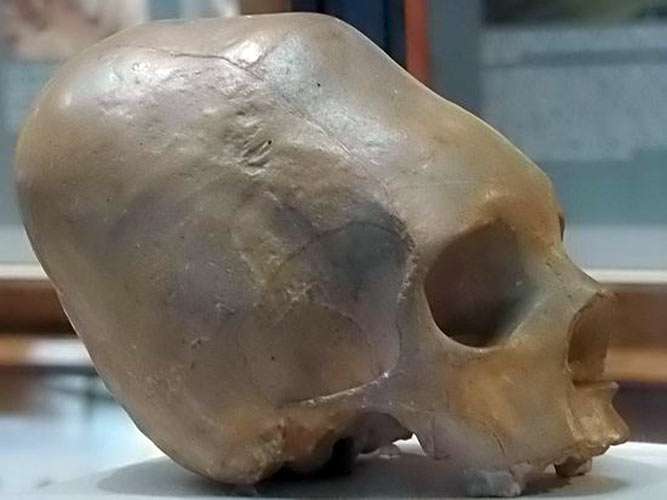
|
Gothic skull, 4th century, Globasnitz. (From Frans Glazer, Die Goten und der Arianismus im Alpen-Adria-Raum in: Rom und die Barbaren: Europa zur Zeit der Völkerwanderung, Bonn, 2008; Globasnitz (Karinthië, Oostenrijk), Gräberfeld Ost.) Source: The Alans. |

|
Child's skull, early 5th century, from Schiltern in Lower Austria. Source: Burgund Synopsis. |
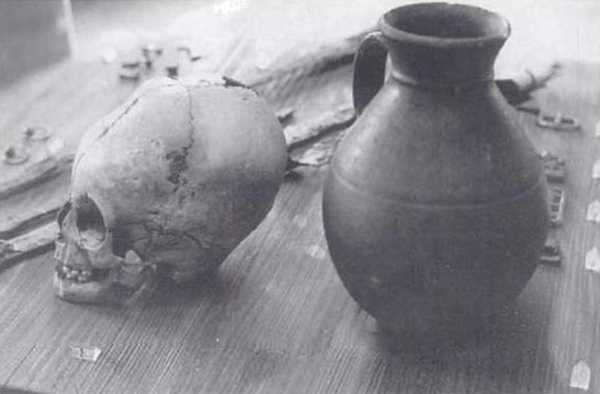 \
\
|
Female Hun elongated skull at the Hungarian National History Museum. The Huns were a nomadic group of people who are known to have lived in Eastern Europe, the Caucasus, and Central Asia between the 1st century AD and the 7th century. Elongated skulls were common among them. There is an interesting document, Artificially deformed crania from the Hun-Germanic Period (5th–6th century ad) in northeastern Hungary: historical and morphological analysis that goes into depth into the elongated skulls of the Huns, but interpreted as artificially deformed skulls. They distinguish four different types of elongated skulls. |
 |
 How a Hun woman looked like. Image by Marcel Nyffenegger. |
 Skull in Hungarian Natural History Museum Budapest |
|
The Hypogeum of Hal Saflieni |
Picture of elongated skulls once displayed in the La Violetta museum in Malta, but removed in 1985. |
|
Here is an interesting story of great significance, because the longheads are associated with what is believed to be the oldest underground temple in the world, the Hypogeum of Hal Saflieni. 7000 remains of people with elongated skulls were found in this underground temple. How did they all end up there? It is highly suggestive that they were all murdered, like what happened in England. A sudden genocide by invading round skull people. As in the rest of Europe, Malta was no exception to the fact that in Neolithic times, it was populated by long skull people, which were of a different race than the round skull Homo sapiens. Below you will find an article by John Black that has been going around on the web. But first I will show you another reference I found in an old book with more pictures of the Hypogeum skulls, taken in the early 1900's. In Malta and the Mediterranean Race (1912) , Robert Noël Bradley mentions that "Broadly speaking, his theory [he refers to Professor Sergi, of Rome) of the Mediterranean Race is as follows: Leaving out of the question the most ancient palaeolithic inhabitants of Europe, this continent was peopled in neolithic times by a long-headed (dolichocephalic) folk who to this day form the substratum of the population." (page 29) On page 196, he talks about the skulls exhibited in the Valetta museum at that time: "There are eleven skulls from Hal Saflieni in the Valletta Museum, and the question arises whether we can fit them in to any particular type. 197 Malta and the Mediterranean Race Their cephalic indices are as follows : 75.1, 74.4, 72.9, 75.1, 68.5, 76.5, 66.0, 72.1, 70.3, 67.5, one undetermined, but probably below 66. All are therefore dolichocephalic except three, which are sub-dolichocephalic." Bradley places the Malta skulls at 3000 B.C. In comparison with the typical dolichocephalic skulls of Neolithic man in Europe, the indexes of 66 to 68.5 indicate very long skulls. He then explains: "A representative specimen is given in Fig. 51. Two, however, have the thick skull, low forehead, prominent brow-ridges, and heavy muscular attachments characteristic of Neanderthal race (Fig. 52), although the excessive dolichocephaly and the convexity of the forehead are foreign to this type." Photos (click on image to enlarge) from the book. Left picture shows a side view of two skulls. Right picture shows four different types of shapes of the Hal Saflieni skulls. |
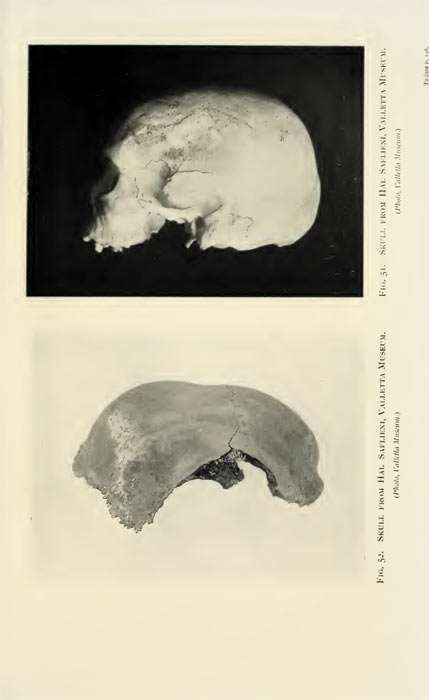 Fig. 51 Skulls from Hal Saflieni, Valetta Museum |
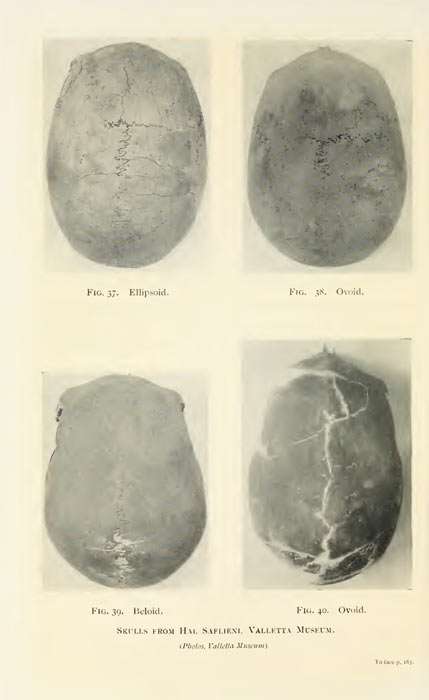 Fig. 39 Skulls from Hal Saflieni, Valetta Museum |
|
John Black wrote an interesting article on the website Ancient Origins: The Hypogeum of Hal Saflieni and an unknown race with elongated skulls Many ancient megalithic structures exist in Malta
and one of them is the ‘Hypogeum of Hal Saflieni’, a subterranean structure
with magnificent properties that is more than 5,000 years old. The Hypogeum
(a Greek word meaning ‘underground’) is supposed to be the oldest prehistoric
underground temple in the world. Newspaper article that showed a picture of two of the Malta elongated skulls: |
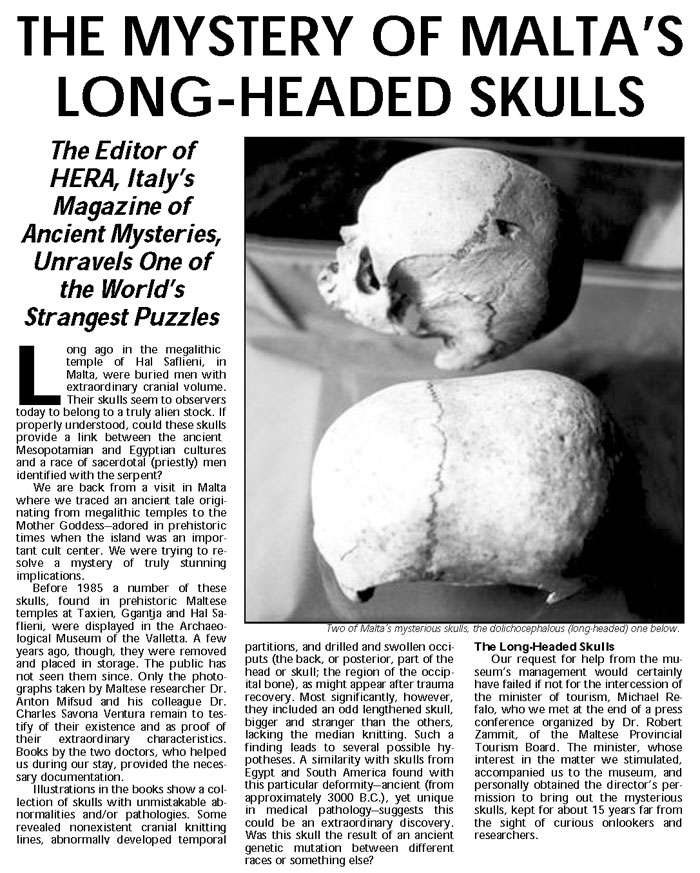
|
In 2024-2025 The National Museum of Archaeology in Valletta had an exhibition of some of the long skulls which had not been publicly exhibited since 1995. Here is a clear picture of the skull that had no sagittal suture at all, what means that this was a different kind of human. The archaeologist explain that the sagittal suture has fused over time, but that is wrong, because the coronal suture has not fused, as you can see in the picture. If suture fuse over time, then they all do it together, and they always leave a visible remain of their original suture. In this skull there is absolutely no sign of any fusion of the sagittal suture:
|
|
The following picture is from Joie de Vivre website, and was photographed at the National Museum of Copenhagen. Left and middle skulls are elongated and trepanned. Left and middle skulls are elongated and trepanned. |

|
Like in the rest of Europe, Italy's Neolithic people were also dolichocephalic or long skull people, as evidenced in The Prehistoric Races of Italy by Isaac Taylor, 1891: "Skulls which are believed to be of Palaeolithic age have been found in various parts of Italy — at Olmo, at Isola del Liri, at Mentone, and in some Sicilian caves. They are all dolichocephalic, or long skulls." (page 490) In accordance with the English archaeologist John Thurnam, he also states that they were rather short people: "In the early Neolithic period we find skulls of the Iberian type all over western Europe, in Caithness, Yorkshire, Wales, and Somerset, in the south of France, in Spain and Italy. This race was swarthy, with olive complexion and black curly hair; it was orthognathous, leptorhinic, and highly dolichocephalic, with a low orbital index, and short stature, averaging about 5 feet 4 inches. " (page 491) Again two races of round and long skull people together: "In the early Neolithic period we find in Italy only these two races, the dolichocephalic, or longheaded, Iberian race, who are physically allied to the North African tribes, and the brachycephalic, or round-headed, Liguijan race, allied to the Lapps and Finns. These two races inhabited the same caves, together or in succession. Thus in a Neolithic cave at Monte Tignoso, near Livorno, two skulls were found, one of the Iberian type, with an index less than 71, and another of the Ligurian type, with an index of 92. In another Neolithic cave, called the Caverna della Matta, an Iberian skull was found with an index of 68, and a Ligurian skull with an index of 84. No anthropologist would admit that these skulls could have belonged to men of the same race." (page 492) An cephalic index of 68 would be called hyperdolichcephalic. That is a very long skull for the European long skull race. |
|
Luhdanjoki Skulls in the National Museum of Finland The skeletons were found in a swamp that was used throughout the ages by different peoples. Those skeletons that had elongated skulls are considered to be from a different human race, but the archaeologists are not sure to what people they belong to. They are not from the Scandinavian, Finnish or Sami races. Based on the animal bones found with them, radio-carbonating shows that they belong to a period from pre-Roman Iron Age to the early Middle Ages. The human skeletons were found with valuables, and thus they were not slaves. there were also no traces of violence, so it is suspected that the place was rather a cemetery and not a sacrificial place. Source: Wikipedia Finland The skulls are in the National Museum of Finland, Helsinki, Finland |
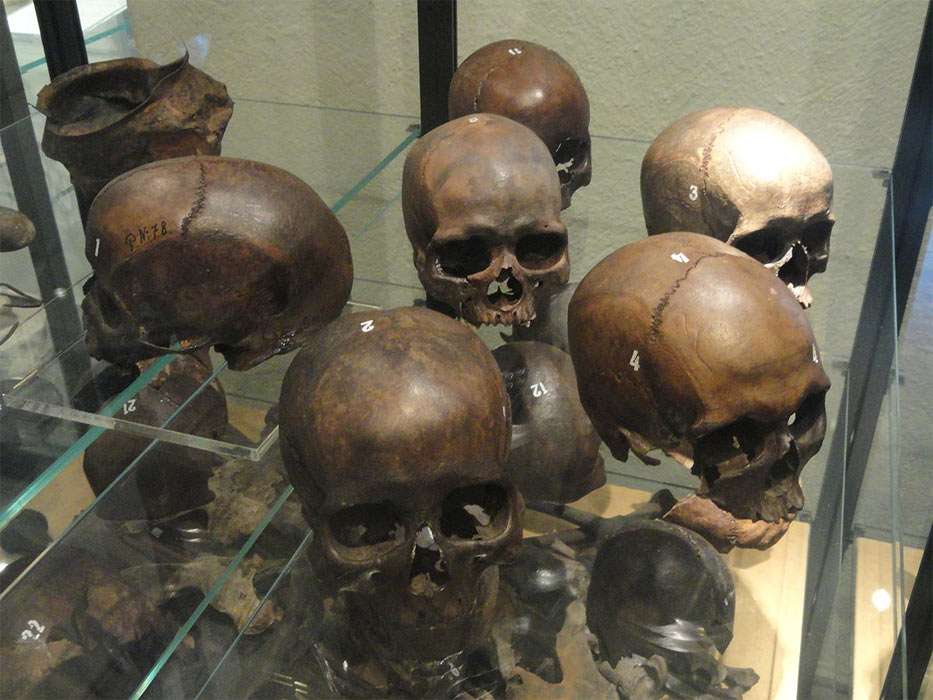
|
This skull is displayed in Archaeological Museum of Agios Nikolaos, Crete. The skull was found in the first century Roman cemetery at Potamos, Crete. It is believed to be the skull of an athlete, hence the gold wreath of olive leafs. The coin in its mouth (to pay the fare to Charon for the passage to the underworld) date from the 13-47AD. This is clearly a dolichocephalic, or long skull. |
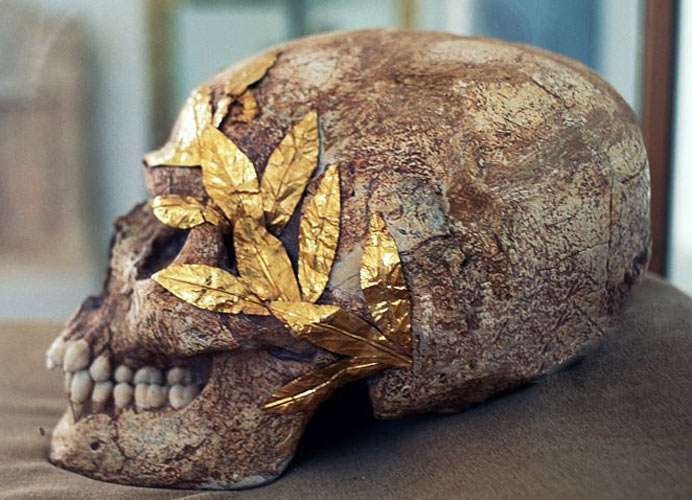 |
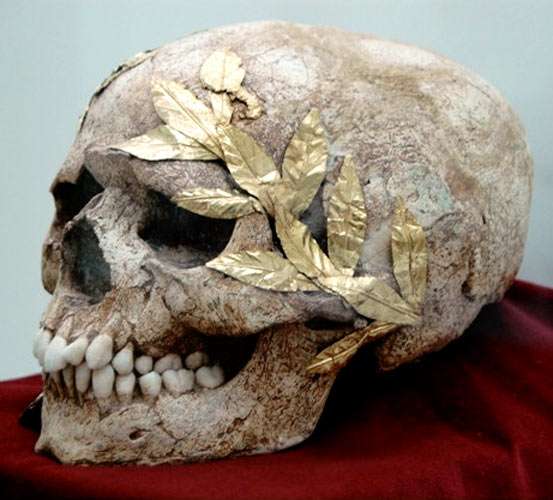 |
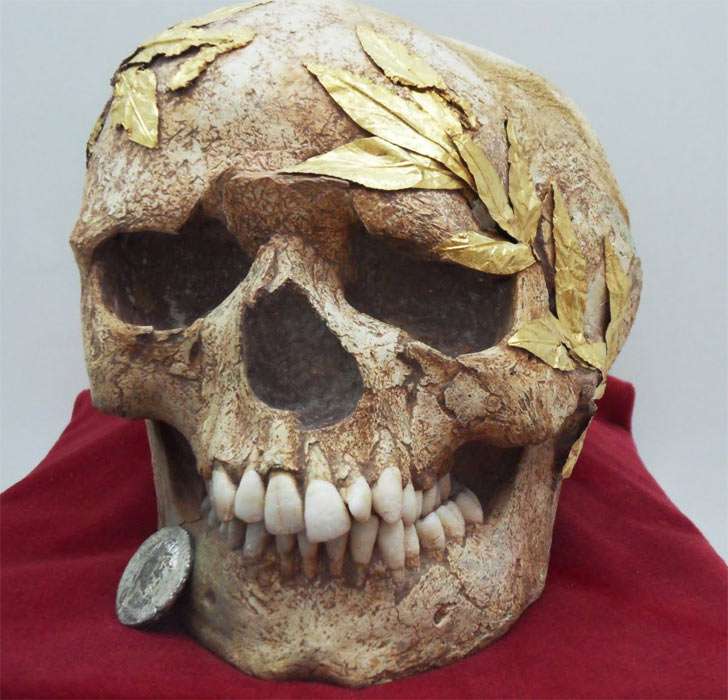 |
The eye sockets are weird too, with heavy brow ridges, hanging in front
of the eye ball. Compare with a normal human skull: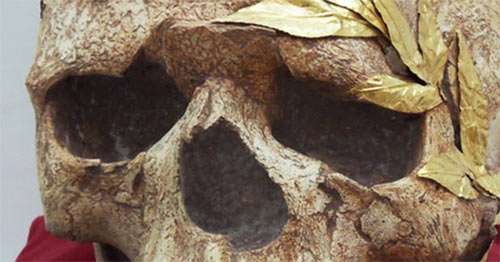 normal human: 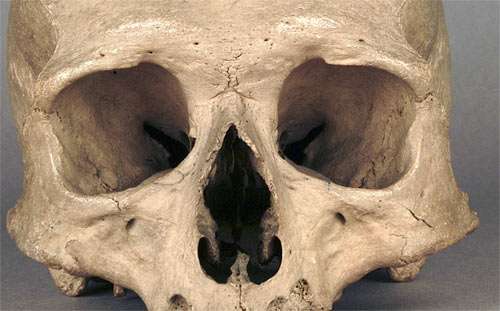 |
|
Three skeletons dating to the Great Migration Period (5th-6th century CE) were discovered in a pit at the Hermanov vinograd site in Osijek, Croatia. They are likely associated with the Huns or Germanic tribes. They belong to three adolescent males between 12 and 16 years old at the time of death. The skeletons show evidence of similar diets but also of severe malnutrition. All three experienced ill-health during their childhood that was severe and lasting enough to be observed on their skeletal remains. Genetic analyses indicates that the individual without artificial cranial deformation shows broadly West-Eurasian associated-ancestry, the individual with slanted elongated skull has East Asian ancestry and the third individual with slanted elongated skull has Near-Eastern associated-ancestry. Source: Cranial deformation and genetic diversity in three adolescent male individuals from the Great Migration Period from Osijek, eastern Croatia from https://journals.plos.org) |

Computer rendering of one of the elongated skulls with East-Asian origin.
|
|